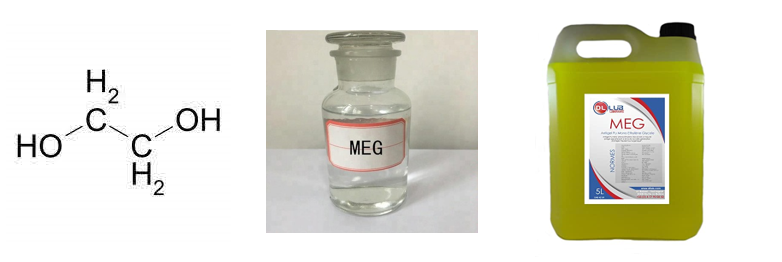MONOETHYLENE GLYCOL (MEG) , is a colorless, oily liquid produced commercially from ethylene oxide. It is widely used as antifreeze in automobile cooling systems and in the manufacture of man-made fibres, low-freezing explosives, and brake fluid.

Production
Ethylene glycol is produced from ethylene, via the intermediate ethylene oxide . Ethylene oxide reacts with water to produce ethylene glycol according to the chemical equation :
C2H4O + H2O → HOCH2CH2OH
This reaction can be catalyzed by either acids or bases, or can occur at neutral pH under elevated temperatures. The highest yields of ethylene glycol occur at acidic or neutral pH with a large excess of water. Under these conditions, ethylene glycol yields of 90% can be achieved. The major byproducts are the ethylene glycol oligomers diethylene glycol, triethylene glycol, and tetraethylene glycol.
Antifreeze
Pure ethylene glycol freezes at about −12 °C (10.4 °F) but, when mixed with water, the mixture freezes at a lower temperature. For example, a mixture of 60% ethylene glycol and 40% water freezes at −45 °C .
Diethylene glycol behaves similarly. The freezing point depression of some mixtures can be explained as a colligative property of solutions but, in highly-concentrated mixtures such as the example, deviations from ideal solution behavior are expected due to the influence of intermolecular forces.
There is a difference in the mixing ratio, depending on whether it is ethylene glycol or propylene glycol. For ethylene glycol, the mixing ratios are typically 30/70 and 35/65, whereas the propylene glycol mixing ratios are typically 35/65 and 40/60. It is important that the mixture is frost-proof at the lowest operating temperature .
Because of the depressed freezing temperatures, ethylene glycol is used as a de-icing fluid for windshields and aircraft, as an antifreeze in automobile engines, and as a component of vitrification (anticrystallization) mixtures for low-temperature preservation of biological tissues and organs. Mixture of ethylene glycol and water can also be chemically termed as glycol concentrate/compound/mixture/solution.
The use of ethylene glycol not only depresses the freezing point of aqueous mixtures, but also elevates their boiling point. This results in the operating temperature range for heat-transfer fluids being broadened on both ends of the temperature scale. The increase in boiling temperature is due to pure ethylene glycol having a much higher boiling point and lower vapor pressure than pure water, as is typical with most binary mixtures of volatile liquids.
Application Usage
These applications are vital to the manufacture of a wide variety of products, including:
- Resins
- Deicing fluids
- Heat transfer fluids
- Automotive antifreeze and coolants
- Water-based adhesives
- Latex paints and asphalt emulsions
- Electrolytic capacitors
- Textile fibers
- Paper
- Leather
- Automotive
- Electronics / Computers
- Appliances
- Households products/ Consumer Goods
- Pipes, Hoses & Fittings
- Sports & Leisures
Gamma Development Co. offers the most completive prices for this product. For receiving a quote please sends us your inquiry along with the LOI to our email : export (@) gamma-co (.) ir
